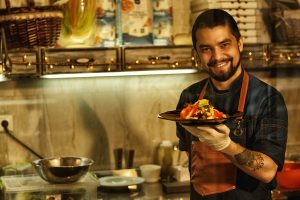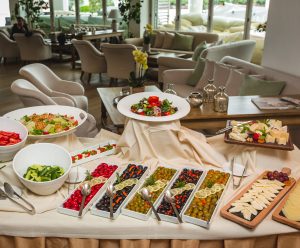Corporate events are often remembered for two things: the networking opportunities and the food. While speeches and presentations shape professional outcomes, it’s the dining experience that fosters connection, conversation, and satisfaction. In today’s fast-paced corporate culture, where employees and clients expect more than a generic buffet, catering has evolved into a strategic tool for engagement.
This case study explores how a corporate event, initially planned as a standard networking dinner, was transformed into a culinary journey of unique flavours, impressing stakeholders, energizing employees, and creating a talking point long after the event ended.
Background: The Corporate Event
The client was a multinational technology firm hosting a two-day leadership summit in Abu Dhabi. The event’s goal was to:
- Strengthen relationships among international executives.
- Celebrate recent milestones.
- Inspire creativity and innovation through immersive experiences.
While the agenda was packed with sessions and keynote addresses, the leadership team wanted the evening dinner to stand out as a highlight of the summit. Their vision: create a dining experience that symbolized innovation, diversity, and collaboration—the very values that drove the company forward.
The Challenge
Initially, the dinner was to feature a conventional three-course meal in a hotel ballroom. However, this approach posed several challenges:
- Predictability: Executives frequently attended formal dinners, and repetition risked disengagement.
- Cultural diversity: Guests hailed from 15 countries, each with unique dietary needs and flavor preferences.
- Innovation alignment: The company wanted food that reflected creativity, much like its technological products.
The challenge was clear: design catering that broke boundaries, celebrated diversity, and sparked conversation while meeting practical dietary needs.
The Catering Strategy
1. Crafting a Theme: “Innovation on the Plate”
The catering team pitched a concept called “Innovation on the Plate.” Each course would represent boldness, creativity, and collaboration, mirroring the company’s values. Instead of one menu for all, guests experienced an interactive, global culinary journey.
2. Unique Flavor Profiles
The menu was built around fusion cuisine—blending familiar comfort foods with global twists. For example:
- Starter: Arabic mezze platters infused with Japanese touches, such as hummus with wasabi and edamame falafel.
- Main Course: Classic Italian risotto infused with Emirati spices and saffron.
- Desserts: French pastries filled with tropical fruits like mango and passionfruit.
This ensured that guests tasted both the familiar and the unexpected.
3. Guest Engagement
The catering team introduced live chef stations, where guests could interact with chefs and customize their meals. Stations included:
- A sushi bar with Middle Eastern spices.
- A pasta corner with international sauces from India, Morocco, and Italy.
- A dessert laboratory where liquid nitrogen ice cream was made on the spot.
The goal: turn dinner into an interactive conversation starter.
4. Cultural and Dietary Sensitivity
The caterers carefully incorporated vegetarian, vegan, gluten-free, and halal options. Each station displayed clear labels and cultural notes, ensuring inclusivity.
Execution: Bringing the Plan to Life
1. Venue Transformation
The ballroom was redesigned with:
- Themed décor combining technology and dining—LED-lit tables, digital menu displays, and projection walls showing global food cultures.
- Seating zones that encouraged mingling rather than rigid arrangements.
2. Timing and Flow
The event was structured to keep energy levels high:
- Cocktail reception with light bites.
- Interactive dinner with live stations.
- Dessert showcase followed by networking.
3. Staff Training
Staff were trained not just to serve but to tell stories about each dish. Guests learned how recipes fused cultures, turning dinner into a journey of discovery.
Outcome: The Results of Unique Catering
1. Guest Experience
Feedback from the 200+ attendees highlighted:
- Surprise and delight at the fusion flavors.
- Appreciation for inclusivity across dietary needs.
- High engagement at chef stations, with many guests taking photos and sharing on social media.
2. Business Impact
The dinner achieved its goals beyond expectation:
- Executives mingled more freely in interactive spaces.
- The innovative dining mirrored the company’s brand, reinforcing its message of creativity and progress.
- Media coverage of the summit featured the dinner as a standout moment.
3. Long-Term Benefits
- The catering success inspired the company to integrate unique flavors into future events globally.
- Employees and partners viewed the brand as not just professional but also creative, culturally aware, and people-focused.
Lessons Learned from the Case Study
1. Food Is Storytelling
Guests connected deeply when food was used as a metaphor for innovation. The right menu can communicate brand values.
2. Diversity Matters
By respecting cultural and dietary needs, the event fostered inclusion. No guest felt overlooked.
3. Engagement Elevates Experiences
Interactive food stations turned dinner into an activity, not just a meal. This approach broke barriers and encouraged networking.
4. Unique Doesn’t Mean Expensive
While the menu was innovative, costs were controlled by:
- Using seasonal, local ingredients.
- Limiting plated courses and maximizing buffet-style options.
- Simplifying décor through creative digital displays rather than extravagant floral arrangements.
Future Implications: What This Means for Corporate Catering
This case study highlights the shift in corporate catering from formality to interactivity, from predictable to bold. Moving forward, catering in the business world will likely emphasize:
- Personalization – Menus tailored to company values and guest preferences.
- Cultural fusion – Celebrating diversity through global flavors.
- Technology integration – Using digital tools to enhance experiences.
- Sustainability – Incorporating eco-friendly practices in menu planning and service.
Catering is no longer a side element—it’s a strategic component of event success.
Conclusion: Flavours That Shape Memories
The transformation of this corporate event proved that catering isn’t just about feeding people—it’s about creating experiences. By blending global flavours, interactive dining, and cultural inclusivity, the event turned a standard dinner into a powerful brand statement.
For companies seeking to elevate their events, catering offers endless possibilities. When thoughtfully planned, food becomes a connector, a storyteller, and the spark that turns a routine gathering into a memorable milestone.






